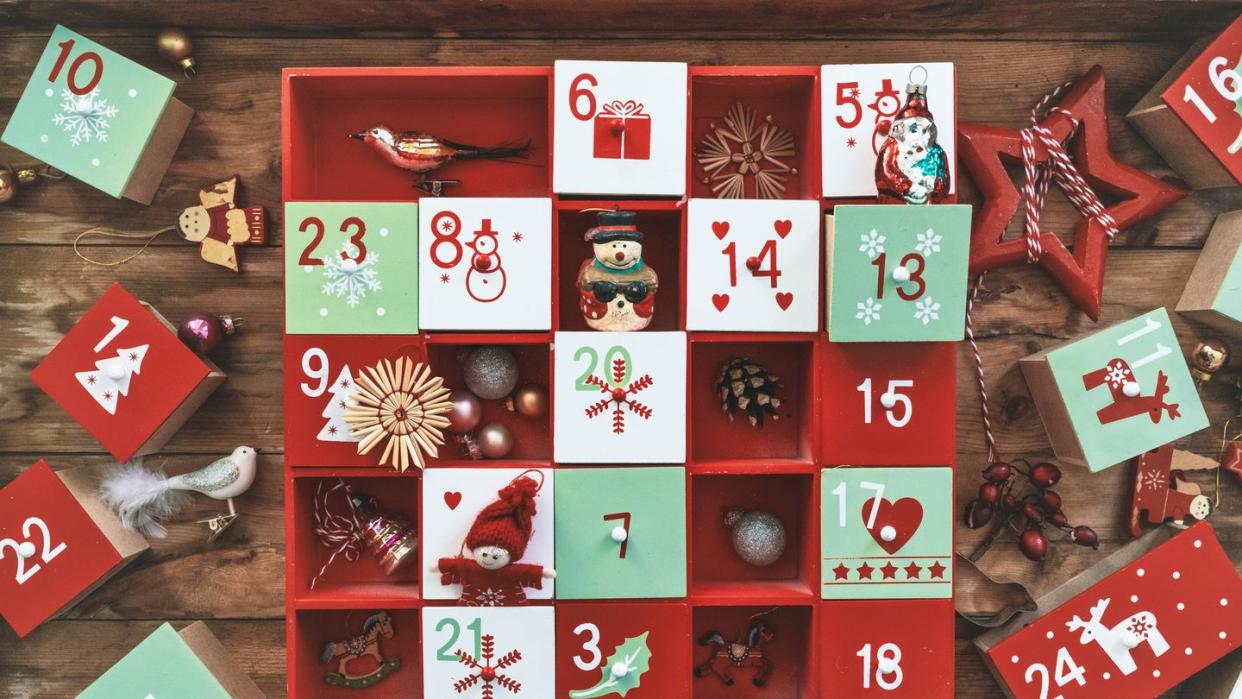What Are Advent Calendars, And How Did They Come to Be?

"Hearst Magazines and Yahoo may earn commission or revenue on some items through these links."
With the approach of cold weather and shorter days, many of us are already starting to think about the holiday season — aka advent calendar season.
Regardless of what you celebrate during the winter months, it's likely that you've come across an advent calendar at some point, opening its miniature windows and cubbies each day of December to reveal chocolates, wine, or even Star Wars trinkets. You may have even wondered, "What is an advent calendar, and where does this tradition come from?"
Here, we're looking back at the advent calendar's origins and how this tradition has evolved over the years.
The Origins of the Advent Calendar
The advent calendar tradition originated in Germany in the late 1800s. Devout Protestants would mark the days of Advent (the four Sundays between the feast day of St. Andrew the Apostle and Christmas) by burning candles, placing straws in a nativity crib, or marking the walls with chalk.
In 1838, German Lutheran pastor Johann Wichern started using an advent wreath to countdown to Christmas in his congregation. Some people eventually started hanging up devotional images each day of December, which progressed into the creation of wooden advent calendars around 1851.
After the first printed calendars started appearing at the start of the 20th century, German publisher Gerhard Land created the first printed advent calendar in 1903. Similar to today's advent calendars, his featured small doors and windows to be opened each day before Christmas, revealing a trinket, rhyme, or bible verse.
Shortly before World War II, however, Lang’s advent calendar business shut down. The war also put steep rations on cardboard, which halted advent calendar production. But post-war, a widely regarded publisher named Richard Sellmar started printing advent calendars and revived the custom.
How Have Advent Calendars Evolved?
Over the last century, advent calendars have become less about observing the days of the Advent and more about getting in the Christmas spirit. By the 1950s, many advent calendars started featuring small gifts and goodies like chocolates.
In 1953, they became incredibly popular after President Dwight D. Eisenhower was photographed opening one with his grandchildren. The photo ran in national newspapers, and the advent calendar instantly went mainstream.
Since then, advent calendars have remained a favorite holiday tradition all around the world. Today, you can find advent calendars that are chockful of beauty products, LEGOs, pet treats, and so much more.
How Is Advent Celebrated Around the World?
Croatia
Because a large percentage of Croatia’s population happens to be Roman Catholic, celebrating Advent is important to the country’s most pious people. Many of them start observing as early as St. Catherine’s Day, which falls on November 25.
Many in Croatia still use the Advent wreath. On Advent Sunday — or the Sunday before Christmas — they start lighting one of four candles, lighting another candle every day, until Christmas Day.
Many residents of Zagreb, the country’s capital, also partake in outdoor markets, where vendors sell crafts, mulled wine, and other goodies.
Mexico
Las Posadas (which translates to “the inns”) is a tradition that is widely celebrated in Mexico, honoring Mary and Joseph’s search for a safe place to rest and to give birth to Baby Jesus.
Celebrations involve a rehearsed caroling session, followed by a feast. Groups of people playing “travelers” will sing to the “host families,” asking to be let in, and after some convincing, they make peace.
In the end, the “host families” serve a massive feast — which generally includes traditional Mexican dishes such as tamales or pozole.
Denmark
In Denmark, as well as in many other Nordic countries, families often get to enjoy Julekalender together. Julekalender is a TV program that dates back to 1962 — starting on December 1, a new episode of the series airs each night until Christmas Eve.
Although it’s different every year, the plot of the show always tends to be vaguely similar — someone tries to sabotage Christmas, they aren’t successful, and ultimately, everything works out in the end.
Similar to the tradition of watching Hallmark movies or Freeform’s 25 Days of Christmas, it’s a fun way for families to enjoy the countdown to Christmas together.
Italy
In the 9 days leading up to Christmas Day, families in Italy celebrate Novena. During this time, children go around the neighborhood and recite the rosary for their neighbors, which is generally done in exchange for candy, cakes, or even money.
Families also set up manger scenes in their homes, where they light candles and pray each day through Christmas.
You Might Also Like

